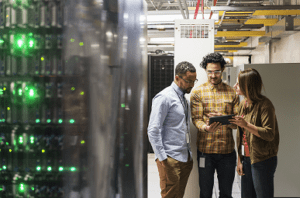Efficient, well-managed data centers are essential for enterprises to successfully compete in modern commercial markets. Data center infrastructure management (DCIM) is a valuable tool that can help enterprises streamline processes, cut operating costs and improve the bottom line.
But DCIM also provides huge benefits to research and educational enterprises such as medical centers and universities.
The latter in particular typically are supporting a computing environment and data ecosystem – student information and accounts, coursework, faculty and administrative records and access, library collections, ongoing research, financial contributions, workstations, electronic classrooms and much more — with a hodge-podge of infrastructure equipment and technology platforms, some dating back to the punch-card era.
One major U.S. university is using DCIM to manage a 5,000-square-foot data center that services more than 50,000 email accounts, hundreds of workstations and nearly 50 electronic classrooms. Built in the 1960s, the university’s data center includes mainframe, AIX, UNIX and Solaris machines, along with HP blades, IBM storage, NetApps storage and local storage.
Constrained by an operating budget and location realities (a densely packed major city), the university’s IT department has had to implement server technology in a room designed for mainframes – not an ideal situation from an operational standpoint. Air flow becomes a challenge, and power usage inefficient, both wasting money and shortening the life of equipment in the room.
The university decided to hire a facilities manager to implement DCIM – not just to save money, but to reduce the university’s carbon footprint.
Going “green” with a data center built in a room for mainframes is a daunting task. But DCIM empowers data center professionals to analyze and restructure data center components in a way that optimizes space and power usage.
For example, the university’s new facilities manager installed meters on every power feed in the data center, enabling him and his small staff to determine how much electricity every piece of equipment was using. This helped them identify and shut down idle servers that were consuming power.
They also were able to analyze air flow and heat distribution, using the data to reconfigure the room to rack and stack servers, create more space and cut utility expenses.
DCIM also helps the university make data center purchasing decisions and assess the performance of new servers versus the claims made by vendors. Once equipment is up and running, DCIM data can immediately gauge how much power it’s consuming.
Perhaps most importantly, the university’s focus on data center infrastructure management has allowed it to do a better job of delivering services to its main customers – thousands of students trying to gain an education.
